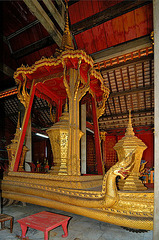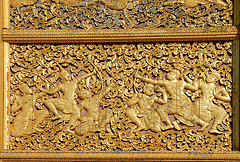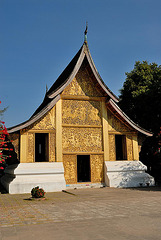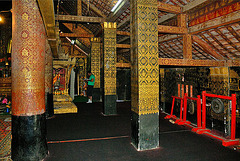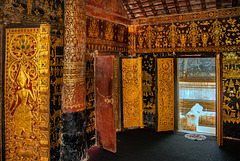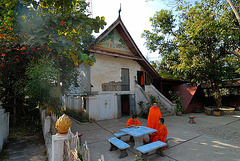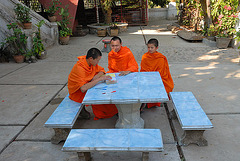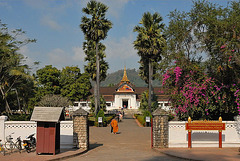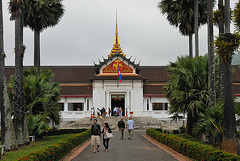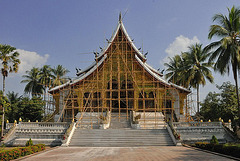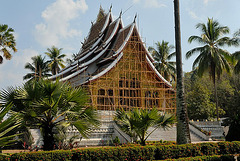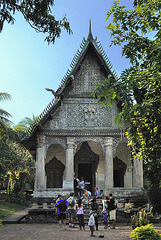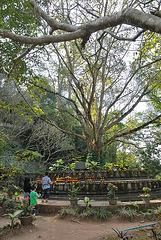
Luang Prabang and the north of Laos
After all my previous visits to Laos in the last 16 years this excursion to the north and north-east of Laos was one of my most exciting tours in this fascinating country. The destination Phongsali is so much beside the main routes that its better to be reach from Yunnan/China than from the south part of Laos; we did it coming from Oudom Xai 232 km to Phongsali with the speed of 15 - 20 km per hou…
(read more)
The carrier of the cremation urn
| |
|
The cremation urn, which holds the body in a curled up position is deeply carved and gilded.
The battle of Pra Lak and Pra Lam
| |
|
Above the entrance to the Royal Funerary Carriage House is this battle scene from the Lao version of the Ramayana epic, Pra Lak and Pra Lam, in which Ram, his younger brother Lakshman and his monkey companion Hanuman on the left are fighting their enemies.
The Carriage House at Wat Xieng Thong
| |
|
In the near compound's eastern gate stands the royal funerary carriage house, where it houses the funeral carriage, which stands 12 meters high and there are various urns for the members of the royal family.
Wat Xieng Thong
| |
|
Inside, the elaborately decorated wooden columns support a ceiling stencilled in gold with dhammachakka (dharma wheels).
Buddha image inside Wat Xieng Thong
| |
|
On one side of the sim, there are several small halls and stupas that contain Buddha images of the period. There is a reclining Buddha sanctuary, which contains a especially rare reclining Buddha that dates from the construction of the temple.
Wooden colons inside Wat Xieng Thong
| |
|
Gold murals art work on wooden bars give this temple a particularly beautiful style.
Wat Xieng Thong fine inside decoration
| |
|
|
|
The walls and columns are also black with gold stencil, and the beams are red ochre with more gold stencils. This amazing fine art work is unique inside this temple sim.
Painting of Wat Xieng Thong
| |
|
Laotian artists use the temple for a traditional motif sell out to local and foreign tourists.
Monks housing at Wat Xieng Thong
Monks in Wat Xieng Thong
| |
|
The monk at the left hand side i met already many years ago on the same place, when we were celebrating Buddhas washing in Apr. 2001.
Luang Prabang National Museum
| |
|
The Royal Palace (official name "Haw Kham") in Luang Prabang was built in 1904 during the French colonial era for King Sisavang Vong and his family. The site for the palace was chosen so that official visitors to Luang Prabang could disembark from their river voyages directly below the palace and be received there. After the death of King Sisavang Vong, the crown Prince Savang Vatthana and his family were the last to occupy the grounds. In 1975, the monarchy was overthrown by the communists and the Royal Family were taken to re-education camps. The palace was then converted into a national museum.
Luang Prabang National Museum
| |
|
The architecture of the building has a mixed of traditional Lao motifs and French Beaux Arts styles, and has been laid out in a double-cruciform shape with the entrance on one side of the lower crossbar. Above the entrance is a three-headed elephant sheltered by the sacred white parasol, the symbol of the Lao monarchy. The steps to the entrance are made of Italian marble. There are a variety of royal religious objects on display in the large entrance hall.
Statue of Sisavang Vong on the palace grounds
| |
|
Sisavang Vong was King of the Luang Prabang and later Kingdom of Laos from 28th April 1904 until his death on 29th October 1959.
Haw Pha Bang Temple
| |
|
|
The Haw Pha Bang, within the grounds of the Royal Palace Museum of Luang Prabang is one of the latest tourist attractions in the Unesco World Heritage town. Haw Pha Bang is the Royal Palace Chapel, and befitting its name, is a grand building, one of the most prominent in Luang Prabang. The temple was first constructed as early as 1963, but due to numerous upheavals, was only completed in 2006. When we visited Luang Prabang in December 2009, workmen were still putting finishing touches to the temple.
Haw Pha Bang at the National Museum
| |
|
|
The Unesco World Heritage recognition of Luang Prabang gave added impetus to the town to polish its heritage, and to do it in a sustainable, heritage-friendly manner. This lead to restoration of many Laotian temples and the support to cottage industries. After many years of abandonment, the construction of the temple resumed in 1993. Inside this very ornate hall is an exquisite pavillion to house the Pha Bang Buddha Image.
Haw Pha Bang and the garden of the National Museum
Wat Pa Houak at the Phu Si hill
| |
|
This fine little temple is exquisitely situated, nestled amid dense foliage and overlooking the Xiang Thong Road.
Bodhi Tree on the way to the hill top
| |
|
The Bodhi Tree, also known as Bo, was a large and very old Sacred Fig tree (Ficus religiosa) located in Bodh Gaya (about 100 km from Patna in the Indian state of Bihar), under which Siddhartha Gautama, the spiritual teacher and founder of Buddhism later known as Gautama Buddha, achieved enlightenment, or Bodhi. In religious iconography, the Bodhi tree is recognizable by its heart-shaped leaves, which are usually prominently displayed. It takes 100 to 3,000 years for a bodhi tree to fully grow.
On the way to the hill top of Phu Si threr is placed a Bodhi Tree which the pilgrims and visitors of Phu Si respect the holy tree with donations.
Jump to top
RSS feed- Latest items - Subscribe to the latest items added to this album
- ipernity © 2007-2024
- Help & Contact
|
Club news
|
About ipernity
|
History |
ipernity Club & Prices |
Guide of good conduct
Donate | Group guidelines | Privacy policy | Terms of use | Statutes | In memoria -
Facebook
Twitter

